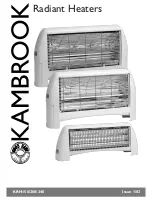
33
G. Water Flow Servo Circuit.
If the heater makes a loud ticking unplug the flow servo (motor behind the internal brass
cold water inlet connection) and run the unit to see if it stops. If so the motor is faulty.
Water Flow Servo Circuit.
From the water flow servo circuit there are 6 wires. They connect to the pcb at
connector A (from the wiring diagram.) Remove the plastic terminal cover so that you
can insert the multimeter leads.
First electrically isolate the unit, disconnect the 6 wire plug at pcb connection A and
measure the resistance between red and blue across the motor (not the pcb)
Resistance should be 10 – 30 Ohms.
If the resistance is incorrect replace the water flow servo and water flow sensor.
If the resistance is correct then power the unit (with the connector (A) plugged in) and
measure the voltage from the pcb by putting the meter leads into the other plug. Do this
with the unit in standby mode (no flow.)
Red – Black
11 – 13 Vdc
(control voltage) Incorrect replace the pcb.
Yellow – Black 4 – 6 Vdc
Incorrect replace flow servo motor
Brown – Black 4 – 6 Vdc
Incorrect replace flow servo motor
Red – Blue
11 – 13 Vdc
Voltage only present when servo is (should be) moving
To remove the flow servo first unclip the cold water pipe in the unit (two screws) and pull
out the copper pipe connection. Bend this out of the way gently. Then remove four
screws from underneath. Now remove the flow servo full assembly.
H. Earth Lead.
Check to make sure that all earth leads are connected and there are no breaks or short
circuits. Checks should be made at the earth lead, pcb, power cord, and surge
protector. If there is a loose connection the Ignition electrode and flame rod will not work
because they need to flash to earth. Tighten any loose connections.
I. Remote control.
Check the voltage at the connector on the right hand side of the unit, above the pcb,
where the controller plugs in. Do this with the power on, but no water flowing.
normal voltage: 11 – 13 Vdc.
If this is correct check the remote wire for damage or shorts. If this is all right disconnect
the remote and turn on the water. If the unit operates correctly replace the remote
control.
If the voltage is incorrect check the water flow sensor (J) before replacing the pcb. If the
water flow servo circuit is working correctly replace the pcb.
Diagnostic Checks
Summary of Contents for FUA-E
Page 1: ......
Page 5: ...5 Glossary of Terms and Symbols ...
Page 9: ...9 Dimensions ...
Page 11: ...11 Structure Diagram ...
Page 17: ...17 Gas Conversion Procedure ...
Page 18: ...18 Gas Conversion Procedure ...
Page 25: ...25 Operational Flow Chart ...
Page 26: ...26 Time Charts ...
Page 39: ...39 Diagnostic Checks Fault Finding Chart ...
Page 40: ...40 Fault Finding Chart ...
Page 41: ...41 Fault Finding Chart ...
Page 42: ...42 Fault Finding Chart ...
Page 43: ...43 Fault Finding Chart ...
Page 44: ...44 Fault Finding Chart ...
Page 45: ...45 Fault Finding Chart ...
Page 46: ...46 Wiring Diagram ...
Page 49: ...49 Dismantling for Service ...
Page 50: ...50 Dismantling for Service ...
Page 51: ...51 Dismantling for Service ...
Page 52: ...52 Dismantling for Service ...
Page 53: ...53 Dismantling for Service ...
Page 54: ...54 Dismantling for Service ...
Page 55: ...55 Dismantling for Service ...
Page 56: ...56 Exploded Diagram ...
Page 57: ...57 Exploded Diagram ...
Page 58: ...58 Exploded Diagram ...
Page 59: ...59 Exploded Diagram ...
Page 60: ...60 Exploded Diagram ...
Page 61: ...61 Parts List ...
Page 62: ...62 Parts List ...
Page 63: ...63 Parts List ...
Page 64: ...64 Parts List ...
Page 65: ...65 Letter of Compliance ...
Page 66: ...66 CE Certificate ...
Page 67: ......
















































